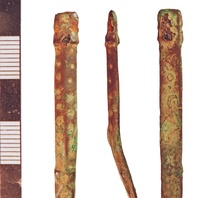
Viking Objects
Stamped Copper-Alloy Casket Mount (NLM-9B6A0B)
A stamped copper alloy casket mount found decorated with stamped ring and dot pattern decoration. Ring and dot pattern was found to be diagnostic of early medieval occupation at Cottam in the East Riding of Yorkshire, and this provides dating evidence for this piece.
Read More
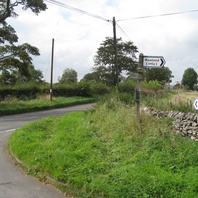
Viking Names
Rowland
Rowland, in the High Peak Hundred of Derbyshire, is a Scandinavian compound from Old Norse rá and Old Norse lundr ‘a small wood’. It is difficult to determine if the first element rá either means ‘a roe, a roe-buck’ or ‘a land-mark, a boundary’. The forms also show the common replacement of lundr with land which also happened in Hasland, Derbyshire.
Read More
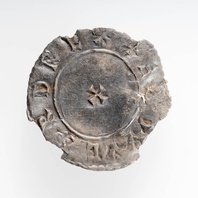
Viking Objects
Edward the Elder Penny (CM.616-1998)
A silver Horizontal type (HT1) penny of Edward the Elder (c. 874-924) minted in London by Garead. Edward was the son of Alfred the Great and succeeded him as king of Wessex. This coin was part of a hoard of twelve coins found at Thurcaston between 1992 and 2000. The coins are Anglo-Saxon, Arabic and Viking issues, and show the diverse and wide-ranging contacts between societies at this time. The hoard was probably deposited c.923-925, approximately five years after Leicester had been retaken by Mercia (c.918). They indicate that a bullion economy was still operating in the Danelaw as late as the 920s. This suggests that the reconquest did not manage to institute Anglo-Saxon practices such as a monetary economy immediately.
Read More
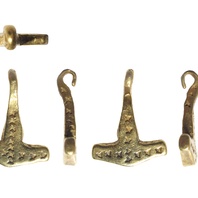
Viking Objects
Hammer-Shaped Pendant (LCNCC: 2015.15)
A gold hammer-shaped pendant with an elongated pentagonal head, popularly called a Thor’s hammer pendant, from Spilsby, Lincolnshire. Hammer-shaped pendants are thought to be amuletic pendants designed to represent Thor’s hammer Mjöllnir. They are common in Scandinavia and in areas of Viking settlement in England. Those found in the Danelaw are generally undecorated or simply decorated, and are thought to have been made in England. The purpose of these pendants has been much speculated about, but nothing definite is known about it. Pendants like this have been found made of lead, copper alloy, silver and gold, showing that many different strata of society could have worn them.
Read More
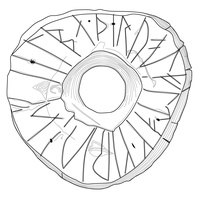
Viking Designs
Drawing of the Saltfleetby Spindle Whorl
Drawing of a lead alloy spindle whorl from Saltfleetby, Lincolnshire showing part of the runic inscription. For further information, see the entry for the original item.
Read More
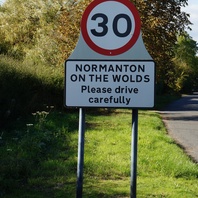
Item
Normanton on the Wolds
Normanton on the Wolds, in the Bingham Wapentake of Nottinghamshire, takes its name from the Old English ethnonym Norðman ‘Northman, Norwegian’ and the Old English element tun ‘farm, settlement’. There are several places of this name, predominantly in the East Midlands: five in Nottinghamshire, one each in Derbyshire, Leicestershire, Lincolnshire and Rutland, and one in the West Riding of Yorkshire. Traditionally, the place-name has been interpreted as referring to a settlement of Norwegians (in an area where most of the Scandinavian settlers were Danes). However, the exact implications of such a name are not yet fully understood and are the subject of ongoing work by Dr Jayne Carroll of the Institute for Name-Studies, University of Nottingham.
Read More

Viking Objects
Bone Comb with Runic Inscription (1867,0320.12)
An original bone comb case with a runic inscription on it which reads, in translation, “Thorfast made a good comb.” The Vikings were known for looking after their personal hygiene. Combs were not only used for combing your hair but also for removing nits and lice.
Read More

Viking Names
Aylesby
Aylesby, in the Bradley Wapentake of Lincolnshire, comes from the Old Norse male personal name Áli and bý ‘a farmstead, a village’. Áli is also the first element of Ailby, Lincolnshire, and Alby, Norfolk.
Read More
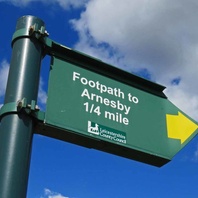
Viking Names
Arnesby
The first element of Arnesby, in the Guthlaxton Hundred of Leicestershire, is likely the Old Danish male personal name Iarund (Old Norse Iǫrundr) which might have given a Middle English form Erendes in the genitive. However, it has been argued that the specific element might be the Scandinavian appellative erendi ‘errand, message’ which may be an unrecorded byname. The second element is Old Norse by ‘a farmstead, a village’.
Read More
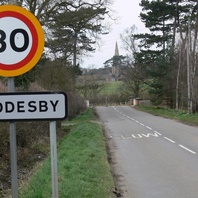
Viking Names
Gaddesby
Gaddesby, in the East Goscote Hundred of Leicestershire, is a Scandinavian compound from the Old Norse male personal name Gaddr, which is an original byname from Old Norse gaddr ‘a goad, a spur’, and Old Norse element by ‘a farmstead, a village’. Alternatively it has been suggested that the first element is Modern English gaddr transferred topographically to the ‘spur of land’ on which the settlement is located. However, it is difficult to conceive the escarpment in which the village sits on as a hill-spur.
Read More
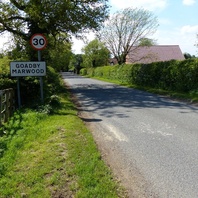
Viking Names
Goadby Marwood
The first element of Goadby Marwood, in the Framland Hundred of Leicestershire, comes from the Old Norse male personal name Gauti (genitive singular Gauta), which is either a short form of names in Gaut- or is derived from an original byname meaning ‘a man from Gautland’. The second element of the place-name is the Old Norse element by ‘a farmstead, a village’. The affix Marwood is the family name of Gaufridus Maureward who held the manor in 1247. The manor remained in the family until at least 1428. The affix Marwood distinguishes the township from Goadby, in the Gartree Hundred of Leicestershire.
